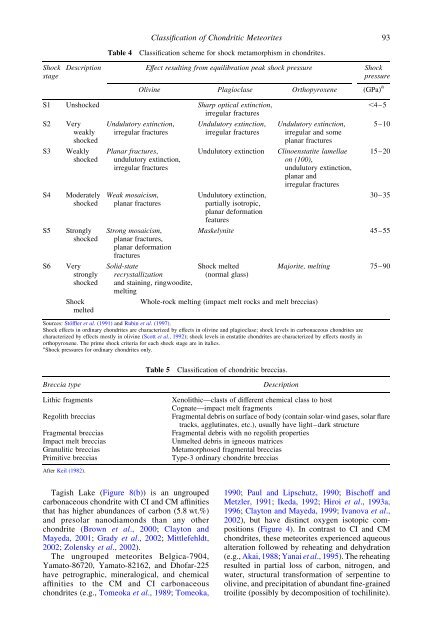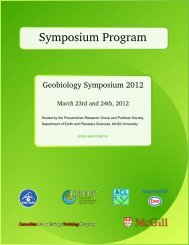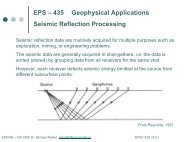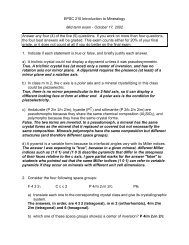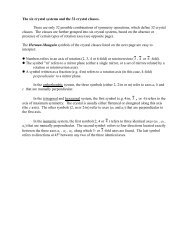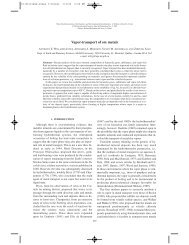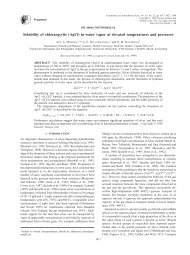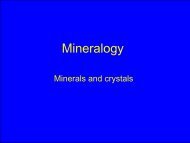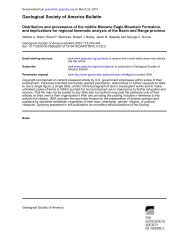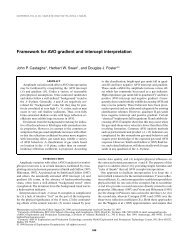05 Classification of.. - Department of Earth and Planetary Sciences
05 Classification of.. - Department of Earth and Planetary Sciences
05 Classification of.. - Department of Earth and Planetary Sciences
You also want an ePaper? Increase the reach of your titles
YUMPU automatically turns print PDFs into web optimized ePapers that Google loves.
<strong>Classification</strong> <strong>of</strong> Chondritic Meteorites 93<br />
Table 4<br />
<strong>Classification</strong> scheme for shock metamorphism in chondrites.<br />
Shock<br />
stage<br />
Description Effect resulting from equilibration peak shock pressure Shock<br />
pressure<br />
Olivine Plagioclase Orthopyroxene (GPa) a<br />
S1 Unshocked Sharp optical extinction, ,4–5<br />
irregular fractures<br />
S2 Very Undulutory extinction, Undulutory extinction, Undulutory extinction, 5–10<br />
weakly<br />
shocked<br />
irregular fractures irregular fractures irregular <strong>and</strong> some<br />
planar fractures<br />
S3<br />
Weakly<br />
shocked<br />
Planar fractures,<br />
undulutory extinction,<br />
irregular fractures<br />
Undulutory extinction<br />
Clinoenstatite lamellae<br />
on (100),<br />
undulutory extinction,<br />
planar <strong>and</strong><br />
irregular fractures<br />
15–20<br />
S4 Moderately Weak mosaicism, Undulutory extinction, 30–35<br />
shocked planar fractures partially isotropic,<br />
planar deformation<br />
features<br />
S5 Strongly Strong mosaicism, Maskelynite 45–55<br />
shocked planar fractures,<br />
planar deformation<br />
fractures<br />
S6 Very Solid-state<br />
Shock melted<br />
Majorite, melting 75–90<br />
strongly recrystallization<br />
(normal glass)<br />
shocked <strong>and</strong> staining, ringwoodite,<br />
melting<br />
Shock<br />
Whole-rock melting (impact melt rocks <strong>and</strong> melt breccias)<br />
melted<br />
Sources: Stöffler et al. (1991) <strong>and</strong> Rubin et al. (1997).<br />
Shock effects in ordinary chondrites are characterized by effects in olivine <strong>and</strong> plagioclase; shock levels in carbonaceous chondrites are<br />
characterized by effects mostly in olivine (Scott et al., 1992); shock levels in enstatite chondrites are characterized by effects mostly in<br />
orthopyroxene. The prime shock criteria for each shock stage are in italics.<br />
a Shock pressures for ordinary chondrites only.<br />
Table 5<br />
<strong>Classification</strong> <strong>of</strong> chondritic breccias.<br />
Breccia type<br />
Lithic fragments<br />
Regolith breccias<br />
Fragmental breccias<br />
Impact melt breccias<br />
Granulitic breccias<br />
Primitive breccias<br />
Description<br />
Xenolithic—clasts <strong>of</strong> different chemical class to host<br />
Cognate—impact melt fragments<br />
Fragmental debris on surface <strong>of</strong> body (contain solar-wind gases, solar flare<br />
tracks, agglutinates, etc.), usually have light–dark structure<br />
Fragmental debris with no regolith properties<br />
Unmelted debris in igneous matrices<br />
Metamorphosed fragmental breccias<br />
Type-3 ordinary chondrite breccias<br />
After Keil (1982).<br />
Tagish Lake (Figure 8(b)) is an ungrouped<br />
carbonaceous chondrite with CI <strong>and</strong> CM affinities<br />
that has higher abundances <strong>of</strong> carbon (5.8 wt.%)<br />
<strong>and</strong> presolar nanodiamonds than any other<br />
chondrite (Brown et al., 2000; Clayton <strong>and</strong><br />
Mayeda, 2001; Grady et al., 2002; Mittlefehldt,<br />
2002; Zolensky et al., 2002).<br />
The ungrouped meteorites Belgica-7904,<br />
Yamato-86720, Yamato-82162, <strong>and</strong> Dh<strong>of</strong>ar-225<br />
have petrographic, mineralogical, <strong>and</strong> chemical<br />
affinities to the CM <strong>and</strong> CI carbonaceous<br />
chondrites (e.g., Tomeoka et al., 1989; Tomeoka,<br />
1990; Paul <strong>and</strong> Lipschutz, 1990; Bisch<strong>of</strong>f <strong>and</strong><br />
Metzler, 1991; Ikeda, 1992; Hiroi et al., 1993a,<br />
1996; Clayton <strong>and</strong> Mayeda, 1999; Ivanova et al.,<br />
2002), but have distinct oxygen isotopic compositions<br />
(Figure 4). In contrast to CI <strong>and</strong> CM<br />
chondrites, these meteorites experienced aqueous<br />
alteration followed by reheating <strong>and</strong> dehydration<br />
(e.g., Akai, 1988; Yanai et al., 1995). The reheating<br />
resulted in partial loss <strong>of</strong> carbon, nitrogen, <strong>and</strong><br />
water, structural transformation <strong>of</strong> serpentine to<br />
olivine, <strong>and</strong> precipitation <strong>of</strong> abundant fine-grained<br />
troilite (possibly by decomposition <strong>of</strong> tochilinite).


